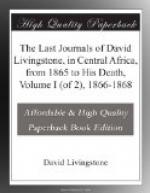29th October, 1868.—In coming north in September and October, the last months of the dry season, I crossed many burns flowing quite in the manner of our brooks at home, after a great deal of rain; here, however, the water was clear, and the banks not abraded in the least. Some rivulets had a tinge of white in them, as if of felspar in disintegrating granite; some nearly stagnant burns had as if milk and water in them, and some red oxide of iron.
Where leeches occur they need no coaxing to bite, but fly at the white skin like furies, and refuse to let go: with the fingers benumbed, though the water is only 60 deg., one may twist them round the finger and tug, but they slip through. I saw the natives detaching them with a smart slap of the palm, and found it quite effectual.
Swifts, Senegal swallows, and common dark-bellied swallows appeared at Kizinga in the beginning of October: other birds, as drongo shrikes, a bird with a reddish bill, but otherwise like a grey linnet, keep in flocks yet. (5th December.) They pair now. The kite came sooner than the swallows; I saw the first at Bangweolo on the 20th July, 1868.
1st November, 1868.—At Kabwabwata; we are waiting till Syde comes up that we may help him. He has an enormous number of tusks and bars of copper, sufficient it seems for all his people to take forward, going and returning three times over. He has large canoes on the Lake, and will help us in return.
2nd November, 1868.—News came yesterday from Mpweto’s that twenty-one slaves had run away from Syde bin Habib at one time: they were Rua people, and out of the chains, as they were considered safe when fairly over the Lualaba, but they showed their love of liberty on the first opportunity. Mpweto is suspected to have harboured them, or helped them over the river; this will probably lead to Syde attacking him, as he has done to so many chiefs in Rua. In this case Mpweto will have no sympathy; he is so wanting in the spirit of friendliness to others.
3rd November, 1868.—Sent off men to hasten Syde onwards. We start in two or three days.
The oldest map known to be in existence is the map of the Ethiopian Goldmines, dating from the time of Sethos I., the father of Rameses II., long enough before the time of the bronze tablet of Aristagoras, on which was inscribed the circuit of the whole earth, and all the sea and all rivers. (Tylor, p. 90, quoted from Birch’s Archaeologia, vol. xxxiv. p. 382.) Sesostris was the first to distribute his maps.
8th November, 1868.—Syde bin Habib is said to have amassed 150 frasilahs of ivory = 5250 lbs., and 300 frasilahs of copper = 10,500 lbs. With one hundred carriers he requires to make four relays, or otherwise make the journey four times over at every stage. Twenty-one of his slaves ran away in one night, and only four were caught again: they were not all bought, nor was the copper and ivory




